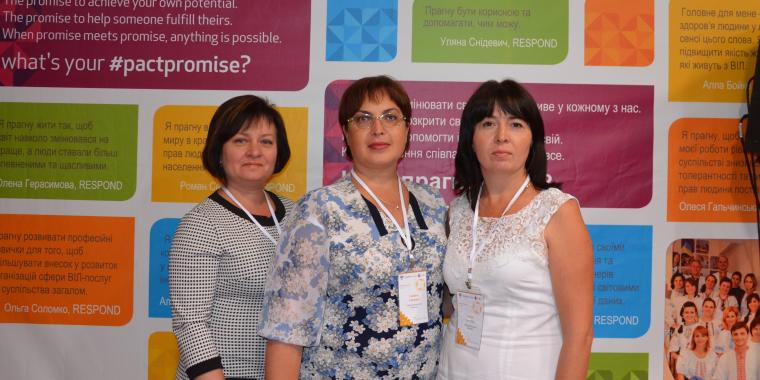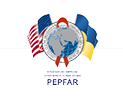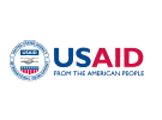
QI COLLABORATIVE OVERVIEW
To improve the continuum of HIV services, from HIV testing to linkage to care, treatment and support for PLHIV in the Kirovograd region, a Quality Improvement Collaborative was established in July, 2016.
In September 2016, members of the Regional QI Implementation Group and local QI teams were approved by the order of the Head of Kirovograd Regional Healthcare Department. According to this order, five local QI teams were created around the existing ART sites.
Each QI team is comprised of the ART site staff, specialty physicians (STI, narcology and OB/GYN), their nurses, primary healthcare practitioners, and social workers of the regional branch of the CF “100% of Life Network”.
Regional QI Implementation Group (RIG): Regional Coordinator – Halyna Horenko, QI Mentor – Nadiya Shutova, Data Quality Mentor – Iryna Babiy.
| Site | QI Coach |
| Kirovograd Regional AIDS Center | Olena Khomyak |
| Dolynska Central Rayon Hospital | Victor Shovkoplyas |
| Novoukrainka Central Rayon Hospital | Lyudmyla Kovalyova |
| Mala Vyska Central Rayon Hospital | Oleksandr Tomak |
| Oleksandriya Central City Hospital | Lyudmyla Zdanovska |
|
Site |
Intervention and NGO |
| Strengthening HIV Services Continuum at the ART Sites CF “100% of Life Network” |
|
| Kherson | X |
| Kakhovkа | X |
| Nova Kakhovka | X |
| Tsyurupynsk | X |
| Skadovsk | X |
| Velyka Lepetykha | X |
| Gola Prystan | X |
| Velyka Oleksandrivka | X |
Milestones of the QI Collaborative in the Kirovograd Region
- On July 19, 2016, the MOU between the USAID RESPOND project, UCDC, and Kirovograd Regional Healthcare Department was signed to improve HIV care and treatment using the QI methodology.
- On April 31 – May 1, 2016, a regional meeting was conducted for 36 healthcare managers and representatives of medical facilities and NGOs. Participants were introduced to the QI model and identified key areas for improvement of the treatment and care for PLHIV in the Kirovograd region.
- A training session for the four QI coaches was conducted on September 13-15, 2016.
- The QI Charter was developed and signed on September 27, 2016. It was approved by the Kirovograd Regional Healthcare Department, Kirovograd Regional AIDS Center, regional branch of the ‘100% Life Network’, and NGO ‘Povernennya do Zhyttia’. The QI Charter includes the gap analysis, changes to be tested, and improvement activities.
- On September 19-21, 2016, the RIG took part in the second cross-regional QI learning session.
- Four computers were purchased for ART sites for running the Simplified Treatment Management Application (STMA) database.
- Information materials on HCT and HIV treatment for patients and physicians were provided by RESPOND.
- The first regional QI learning session was conducted for 5 QI teams/36 people on January 24-25, 2017
- On March 28-29, 2017, RIG and representatives of QI local teams took part in the third cross-regional learning session in Kyiv.
- The second regional QI learning session was conducted for 5 QI teams/48 people on July 7-8, 2017.
- RIG and the RESPOND staff regularly conduct QI mentoring visits to local QI sites (22 in the period of October 2016 – September 2017).
QI Collaborative Change Package in the Kirovograd Region (5 ART sites)
|
Gap |
Change |
Jan-Mar, 2016 |
Apr-Sept, 2016 |
Oct, 2016 – Mar, 2017 |
Apr-Sept, 2017 |
|
1. HIV testing and referral |
1.1. HIV risk assessment by specialty physicians and/or PHC providers |
_ |
_ |
5 |
5 |
|
1.7. Assess behavioral risks and clinical indicators, and provide HTS for in-patients within the first three days of hospitalization |
_ |
_ |
5 |
1 | |
|
2. Linkage and retention in care |
2.3. Transport the biomaterial to the lab more frequently | _ | _ | _ | 1 |
| 2.7. Active home visiting by medical and social workers | _ | _ | 4 | 4 | |
|
2.9. Registering with AIDS service the HIV-positive in-patients before they are discharged from the hospital |
_ |
_ |
5 |
1 | |
|
3. Treatment |
3.1. Initiation and management of ART at ART site |
_ |
_ |
5 |
4 |
|
3.2. Transfer patients on ART from AIDS Centers to local ART sites |
_ |
_ |
1 |
1 | |
|
4. Cross-cutting |
4.1. Implement electronic database for dynamic individual-level PLHIV service tracking |
_ |
_ |
5 |
5 |
|
4.2. Develop and implement region al and local referral protocols/patient pathways |
_ |
_ |
5 |
_ | |
|
4.3. Increase the network of active Trust Offices/ART sites |
_ |
_ |
3 |
_ | |
|
4.4. Train physicians and nurses on HTS |
Х |
– |
– |
_ | |
|
4.5. Train physicians on ART |
– |
– |
Х |
_ | |
|
4.7. HIV rapid tests purchasing by a local/district budget |
_ |
_ |
5 |
_ | |
|
4.8. Meetings of local QI teams at least monthly to analyze changes and data (with special attention to run charts) |
_ |
_ |
5 |
5 | |
|
4.9. Partnering with NGOs (escorting patients by social workers), to enroll PLHIV from key populations in medical care |
_ |
_ |
5 |
5 | |
|
Total Changes Implemented |
– |
– |
12 |
10 |
|
Х – number of QI sites implementing the change is undefined
Key Achievements
- By decree of the Head of the Regional Coordination Council on TB and HIV/AIDS, district administrations and municipalities obliged to allocate additional funds for procurement of the rapid HIV test kits.
- Rapid HIV test kits purchased from local budget for the following ART sites: Central Rayon Hospital of the Novoukrainka district, PHC Center of the Novoukrainka district.
- Four additional ART sites opened, one of them – at the Regional TB Hospital.
- Mala Vyska ART site staffed by the infectious disease doctor position.
- In the Dolynska district, the HIV detection rate among PLHIV sexual partners is 18.5%.
- 1.3 times increase in the number of people screened positive for HIV with rapid tests, in comparison with the previous quarter.
- The number of the ART patients among the PLHIV registered at the five ART sites increased by 4% in comparison with the previous quarter.
- HIV detection rate among the total number of people tested for HIV remains high and makes 7.3% in July-September 2017.
Challenges
- Delays in ARVs supplies.
- Shortage of the rapid HIV test kits.
- Understaffing of ART sites in the region; particularly lack of the social worker positions at the ART sites of the Oleksandriya and Mala Vyska districts.
- Difficulties with introducing the Medical Information System.
Next Steps
- Staffing of ART sites with social and medical worker positions.
- Training for ART site/Trust Office staff on running MIS.
- Engage PHC providers and NGO social workers to active home visiting of patients lost to follow up.
- Continue decentralizing HIV-services, transferring of ART patients from the regional AIDS Center to local ART sites.
- Finalize and approve the QI Charter – 2020.
Key Achievements
Key Achievements
- Rapid HIV test kits for Mala Vyska and Novoukrainka district ART sites purchased from local budget.
- HIV detection rate in the region increased from 5.7% to 9.3%.
- Registration rate among four district ART sites has reached 86% of the number of PLHIV identified.
- As of July 1, 2017, 273 patients on ART transferred from the Regional AIDS Center to local ART sites.
- 48 PLHIV initiated on ART at local ART sites during January-June 2017.
- Dolynska ART site implemented HIV testing and registering of inpatient PLHIV before they are discharged from hospital.
Challenges
- Shortage of the rapid HIV test kits in some districts.
- Untimely supplies of ARVs to ART sites.
- Understaffing of ART sites.
- Poor involvement of specialty physicians to HTS.
- Lack of e-registry of patients.
Next Steps
- Implementing MIS on the regional level.
- Discussing the procurements of the rapid HIV test kits at the Regional Coordinating Council meeting.
- Additional training for specialty physicians and PHC providers on HTS.
Key Achievements
- Rapid HIV test kits for Mala Vyska ART site purchased from local budget.
- Successful decentralization at the two ART sites in Oleksandriya city and Novoukrainka rayon; initiation on ART and scheme management is now made directly at the ART site.
- Specialty physicians and PHC practitioners engaged into risk behavior screening.
- HIV detection rate remains stable (5,4% in Jan-Mar, 2017 against 4,4% in Oct-Dec, 2016).
- Number of PLHIV registered with AIDS service has almost doubled in comparison with the previous quarter (62 people against 35 in October-December).
- Number of PLHIV initiated on ART has 10% increase compared with Oct-Dec, 2016.
- Regional Coordination Council on TB, HIV, and AIDS obliged municipal and rayon administrations purchase rapid tests at the expense of local budgets.
Challenges
- Lack of rapid HIV test kits in some rayons.
- Lack of ART sites in the region.
- Difficulties with implementation of the Medical Information System (MIS).
- Incomplete decentralization of the Dolynka and Mala Vyska ART sites (sites dispense ARVs only).
- Understaffing of some rayon ART sites.
- Lack of the regional lab for CD4 and viral load testing.
Next Steps
- Purchase rapid HIV test kits for Novoukrainka ART site and Kropyvnytsyi (ex-Kirovograd) PHC Center at the expense of local budget.
- Introduce infectious disease doctor and social worker positions at the Mala Vyska ART site.
- Strengthen capacity of the ART sites staff to run MIS.
- Optimize transportation of blood samples to another region for viral load and CD4 testing.
Key Achievements
- Three new ART sites opened in the cities of Oleksadriya, Mala Vyska, and Novoukrainka.
- All five ART sites started testing the QI changes.
- Specialty physicians and PHC physicians engaged into rick behavior screening.
- It has increased the number of patients referred for HTS.
- 78.2% of the total number received provider-initiated HTS in Novoukrainka rayon were referred by the specialty physicians.
- Detection rate in Mala Vyska and Dolynska rayons has increased from 2.7% to 6.3% in Oct-Dec 2016 in comparison with Oct-Dec 2015.
- Five ART sites receive the social support services from the regional branch of the CF ‘100% Life Network’.
- Regional AIDS Center has started the transfer of patients on ART to the local ART sites. Thus, as of February 1, 2017, 66% of patients on ART (or 92 out of 140) living in Oleksandriya City receive ART at the local site.
- Two out of four rayon ART sites started initiating on ART.
- Regional State Administration has issued an order to revise the rayon budgets so to allocate funds to purchase the rapid tests.
Challenges
- Lack of the rapid HIV test kits in some rayons.
- Belated data input into the STMA, and only four ART sites do this.
- Necessity to deliver blood samples to other regions for CD4 and viral load analysis.
Next Steps
- Develop and introduce the clear schedule for timely data input into STMA.
- Set treatment goals for five ART sites for 2017.
- Lobby the decree of the Regional State Administration on allocating funds from local budgets to purchase the rapid HIV test kits.
Challenges
- Lack of the rapid HIV test kits in the region.
- Insufficient number of the ART sites in the region.
- Problems with transporting blood samples from the rayons to the AIDS Center.
- Problems with data collecting and analyzing.
- Low rates of the HIV detection, registration, and initiation on ART in the region.
- Lack of NGOs in some rayons.
Next Steps
- Open three new ART sites (through end 2016)
- Identify changes for piloting at the ART sites.
- Engage specialty physicians to HTS providing.
- Scale-up the work of NGOs to the rayons where ART sites not opened yet.
- Data collection and analysis using the STMA.
HIV Screening, 2015-2017
HIV Detection: Number and Proportion Tested Positive, 2015-2017
Registration at AIDS Service and Initiation on ART, 2015-2017






